![]() 1st Battalion 22nd Infantry
1st Battalion 22nd Infantry ![]()
TF 1-22 Infantry on the Horn of Africa:
OPERATIONS RESTORE AND CONTINUE HOPE—SOMALIA
Edited from TF 1-22 Infantry, from Homestead to Port au Prince
By MAJ John R. Evans, Command and General Staff College, 2000
Part One
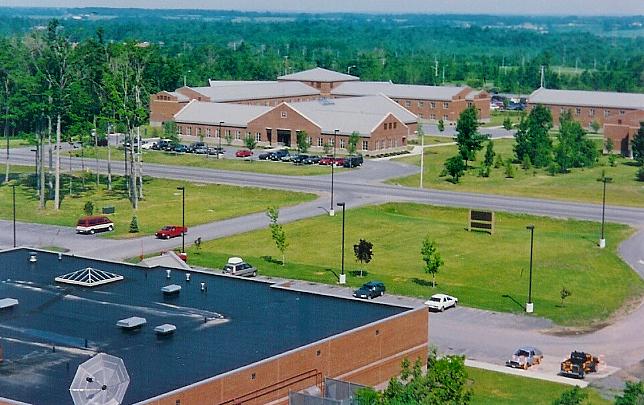
1-22 Infantry Headquarters and Barracks -- Fort Drum, NY
The first week of December 1992 was one of high tension at Fort Drum, New York, as the 10th Mountain Division had been notified that it would participate in humanitarian relief operations in the war-torn and starving country of Somalia. For weeks the national press corps had been dramatizing the death and horror of a starving nation by showing film of the daunted and understaffed nongovernmental organizations that were in country trying to bring food and medical care to the masses. Somalia had been an important part of many nations’ interests, particularly during the Cold War, because of its proximity to the Red Sea and the Persian Gulf. The subsequent loss of international attention after the fall of the Berlin Wall in 1989 left Somalia to depend on its own resources. Somalia slowly slipped into an anarchic state of warring clans and starving people. In 1992, this anarchy, coupled with widespread drought and starvation, contributed to the deaths of over 250,000 Somalis, including a large number of children. An estimated 1.5 million more Somalis were to face starvation in the coming year. These scenes, portrayed continually on television sets around the world, led to the eventual deployment of U.S. forces under the Unified Task Force (UNITAF) to quell the starvation by providing much needed humanitarian relief and support.
Pre-Deployment Part One
The division was to deploy the division headquarters (-), one of its two infantry brigades, a portion of the aviation brigade, and the requisite combat service support from the division support command. Additionally, the division headquarters would act as the ARFOR headquarters of the Joint Task Force (JTF) assigned the relief mission now named Operation Restore Hope, and its 2nd Brigade Combat Team (BCT), the Division Ready Brigade (DRB), would deploy as the operational force on the ground.
There was considerable confusion and discussion as to how 2nd BCT would actually look as it began preparations to deploy. In fact, at least one of its organic battalions was not available for deployment because it was deployed away from home station conducting an off-post training exercise at Fort Pickett, Virginia. Because of the shortage, there was a shift in forces that would normally deploy with the 2nd BCT. The 1st Battalion, 22nd Infantry, the DRF-3, was designated to fill the void and was to deploy as the third battalion of the 2d Brigade.
A few days after notification, the final 2nd BCT task organization was published. Two of the three battalions assigned to the brigade would deploy; 2-87 Infantry and 3-14 Infantry were the chosen combat units. The 1st Battalion, 22nd Infantry, was “turned off” for the initial deployment, but was told to continue preparations. With the decision finalized, 1-22 Infantry returned to normal operations and training plan, always with an eye and ear focused on the Somalia situation, as rumors of a rotation of units into theater began to surface.
Actual Predeployment
By mid-January 1993, the rotation rumors seemed to be correct. During this time, 1-22 Infantry was notified by its parent brigade headquarters (1st Brigade) that it would deploy and backfill one of the battalions in Somalia by April 1993. The U.S. force from the 10th Mountain Division that would continue the mission in support of the United Nations operation was the First Brigade Combat Team with two subordinate battalions. Those battalions were 1-22 Infantry and 3-25 Aviation. This was all a part of a time-phased plan to change the lead headquarters to UN control and to reduce U.S. forces, sometime around May-June 1993.
Upon notification in mid-January 1993, the battalion staff again began detailed planning for the final preparation, deployment, and assumption of the new mission. The focus of preparation training was twofold. First, training vignettes, supplied by units in country and the division staff, were introduced and new techniques were shown to the companies of 1-22 Infantry. Examples of this new training focused on how to conduct security checkpoints and how to search for illegal weapons. Additionally, detailed information briefings on the country and culture were provided to the soldiers to assist in preparing them for what they would be seeing and experiencing. Secondly, the unit planned and executed live-fire training exercises and a battalion STAFFEX (staff exercise) for March 1993, about thirty days before the deployment. This again reinforced the command philosophy that the unit must be prepared to handle the worst and most complex situation and that all lesser, non-combat activities that a light infantry battalion encounters would not be that difficult to perform. As these training events carried on, so did unit equipment preparation tasks.
By the end of February and early March 1993, the battalion was well prepared for what it faced as members of the humanitarian mission in Somalia. The battalion commander, operations officer, and logistics officer all traveled to the actual location that 1-22 Infantry was to operate from. They conducted leader and logistics reconnaissance actions, and the commander approved the final package of troops and equipment necessary to deploy in early April.
With the deployment pending and the reconnaissance completed, the time came for the battalion to send forward an advanced party. The composition of this advanced party was between ten and fifteen leaders and soldiers, most with the logistical background to begin the property transfers between battalions. Additionally, the operations and intelligence officer of 1-22 Infantry deployed in the advanced party to begin the task of learning the intricacies of the Area of Operations and transitioning operations between units. The advanced party flew into Mogadishu, Somalia, via Air Force C-5, during the last few days of March 1993.
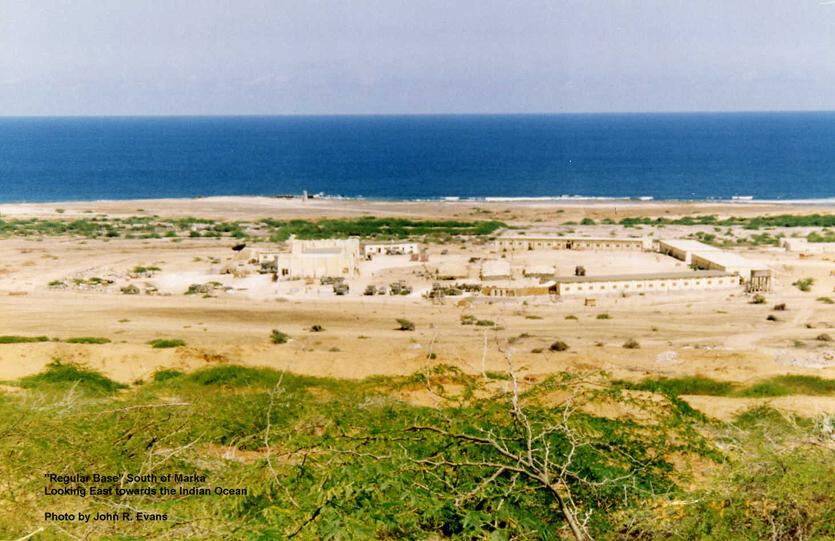
Regular Base ---- South of Marka
Upon arrival in Mogadishu, the battalion’s advanced party was met by a small group of leaders from 2-87 Infantry. The advanced party took up positions in the 2-87 Infantry convoy and moved to its area of operations in the port town of Marka.
The city of Marka is located about sixty miles south of Mogadishu and was critically important to the humanitarian relief effort as it contained one of three ports on the southern coast. The port is a “lighterage” port, meaning that shipping could anchor off shore from the shallow water port, and barges would carry the cargo to and from the port facility. This port was central to the assigned HRS (Humanitarian Relief Sector) and the NGO (Non Governmental Organizations) plan for relief missions. As an alternative to trucking supplies down the dilapidated Afgooye road from Mogadishu into the HRS, the port offered easier transport of larger loads that could be trucked directly into the Humanitarian Relief Sector.
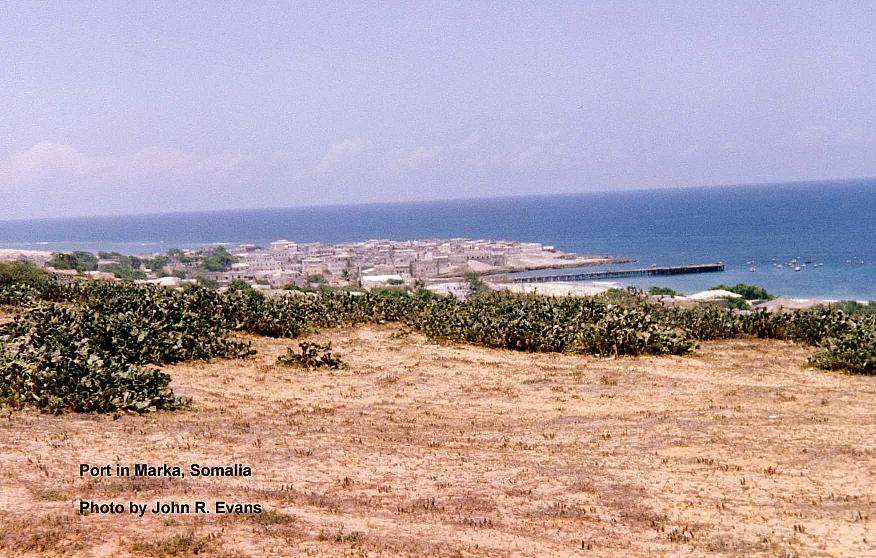
The port of Marka
Upon arrival in Marka, the advanced party began its transition work immediately. The leaders and staff from 2-87 Infantry provided informational briefings and reconnaissance opportunities for the staff and leaders of 1-22 Infantry. The basic scheme of maneuver for the relief in place between battalions was that as an infantry company from 1-22 Infantry arrived, a company from 2-87 Infantry redeployed to Mogadishu and eventually back to Fort Drum. The transition was designed to be most detailed at battalion and company level, but the transition did get down to the platoon level as well. Leaders of the 2nd Battalion, 87th Infantry, would provide oversight and guidance on missions, while 1-22 units and leaders “got on their feet” and felt comfortable with the surrounding area and the mission. The transition was completed and the entire battalion was on the ground and had assumed the HRS mission by 9 April 1993.
The initial mission of the battalion was to occupy HRS Marka, control the port and its operations, ensure security for NGOs, and oversee the humanitarian relief operations. An additional task for the battalion, beyond the responsibility that 2-87 Infantry had, was to provide a “Theater Quick Reaction Force.” Little attention was paid to this fact in April 1993, but that task would in fact change entirely how the United States and UN conducted business in Somalia in the very near future.
|
Humanitarian Relief Sectors (HRS) |
The battalion provided both mounted and dismounted security patrols through the city of Marka and the surrounding countryside. These patrols, usually squad or platoon sized elements, covered the local area at various times of the day and night, looking for suspicious bandit or dangerous clan activity and providing a sense of security for the NGO’s and local population. In addition, several static security checkpoints were established on the main Lines Of Communication (LOCs) leading to and from the port. Each of the line rifle companies and their platoons conducted local security patrols and static security checkpoints to help combat the threats. Mounted platoons (mortars and antitank) accompanied NGO convoys and ensured their security during relief trips through out the sector. The largest threat beyond the bandits on these NGO convoy missions was how to deal with large crowds and the occasional woman or child that would attempt to steal food or cooking oil. This relatively calm environment on the deceptively beautiful coast of Somalia soon changed, as rumors of another change of mission and location began to circulate from the Brigade Headquarters.
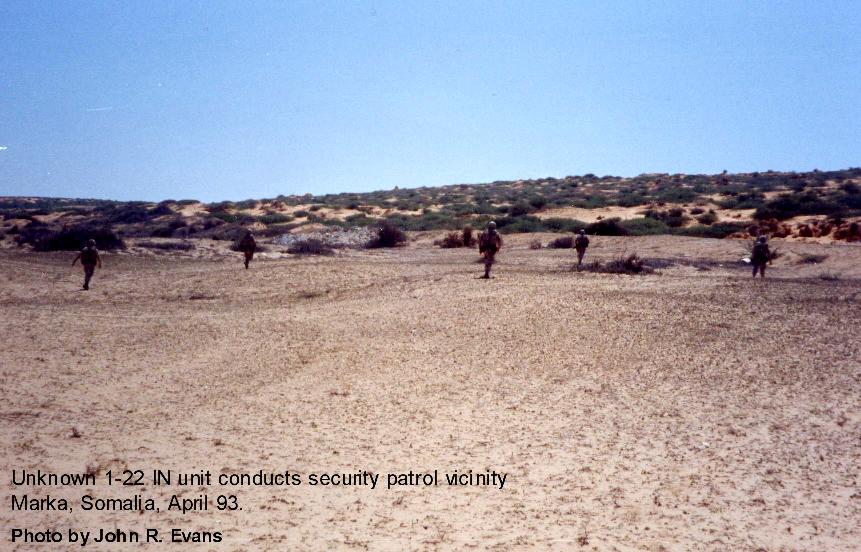
1-22 IN patrolling area around Marka
By the end of April, the battalion turned the HRS over to Pakistani control and reported to Mogadishu for full-time QRF (Quick Reaction Force) operations in support of the UN Headquarters. The transition between 1-22 Infantry and 1st Battalion of the Sind Regiment, Pakistani Brigade, began on 26 April 1993. This was the first time since December 1992 that Marka would be secured by other than U.S. forces. All 1-22 Infantry forces were moved and in place at the University Compound in Mogadishu by 30 April 1993.
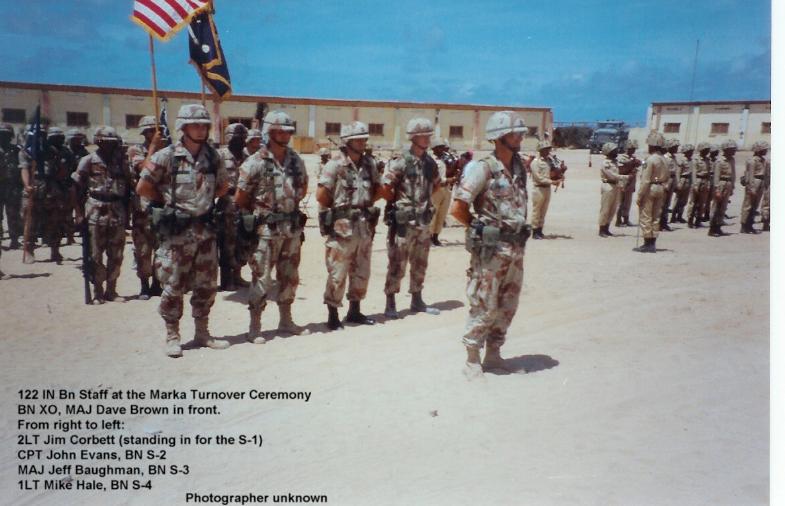
1-22 IN turns over responsibility of
the HRS to the Pakistani Army.
(Troops in the far right, and Bagpipe section in middle rear, are
soldiers from the
1st Battalion of the Sind Regiment, Pakistani Brigade)
May 1993 commenced with a unique problem for 1-22 Infantry. Once all of the unit equipment and soldiers were settled, complete focus turned to Quick Reaction Force missions. The basic problem was that the United Nations Mission in Somalia (UNISOM II) Headquarters (now transitioned from UNITAF) had little idea of what to use the QRF for. Several ideas came forth from the UN headquarters for using the QRF in show-of-force missions around Mogadishu and potentially all of central and southern Somalia. This confusion of what to do with the QRF was compounded at the battalion level, as 1-22 Infantry was required to be able to respond anywhere within the country of Somalia to support local UN forces. This was significant as even UNITAF forces (during the first phases of the operations from December 1992 to March 1993) confined their area of operations to only the southern 40 percent of the country. This larger AOR resulted directly in a lack of focus by the QRF on potential hotspots and threats. Nevertheless, senior U.S. staff members of the UN headquarters wanted to restrict the use of the QRF and deploy it only when necessary. Along with show of force, there were several attempts at using the QRF for humanitarian missions, such as refugee repatriation. One such mission actually resulted in a battalion deployment west to the Kenyan border to repatriate Somali refugees from camps just inside Kenya back to their home towns of Gabahare and Bardera. The repatriation mission, although attempted twice, was never completed because of recurring, more volatile events in the southern port city of Kismayo.
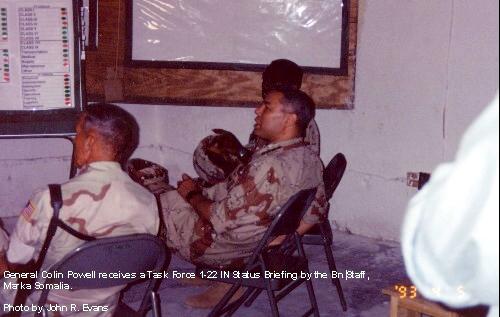
Chairman of the Joint Chiefs of Staff Colin Powell gets
briefed by 1-22 in Marka, Somalia, 1993.
By mid May 1993, it was apparent that the mission of the QRF would in fact be almost exclusively show-of-force missions, and on two occasions, portions of the battalion were sent to patrol with UN forces in Kismayo and out west to the town of Baledogle. The final trip to Kismayo brought about the ultimate change in mission for Task Force 1-22 Infantry. During the end of May, angry crowds and clan infighting were on the rise, particularly in the Kismayo port area. Two warlords (Morgan and Jess) were planning a fight over the control of the city. The Belgian force stationed at the port in Kismayo asked for assistance, and the UNISOM II headquarters dispatched the QRF from the Bardera and Gabahare mission to reinforce the Belgian forces in Kismayo. This show of force was different, as it was to be a coalition operation between U.S. and Belgian forces with the purpose of patrolling and securing the surrounding areas, thereby preventing clashes between Somalis or UN elements. Two companies (Bravo and Charlie companies), along with the battalion TAC, would move using ground and air assets into Kismayo, establish an operating base, and begin security patrols along with Belgian forces. There was a much more tense feeling in the air at this time, especially shown in the behavior of the Belgian forces who expected a fight between armed Somali and UN forces. The coalition forces completed their plans the night of 4 June 1993, and the operation was set to kick off in the early morning hours of 5 June 1993.
**********************
Text and photos are copyright © John R. Evans 2005
Home | Photos | Battles & History | Current |
Rosters & Reports | Medal of Honor | Killed
in Action |
Personnel Locator | Commanders | Station
List | Campaigns |
Honors | Insignia & Memorabilia | 4-42
Artillery | Taps |
What's New | Editorial | Links |